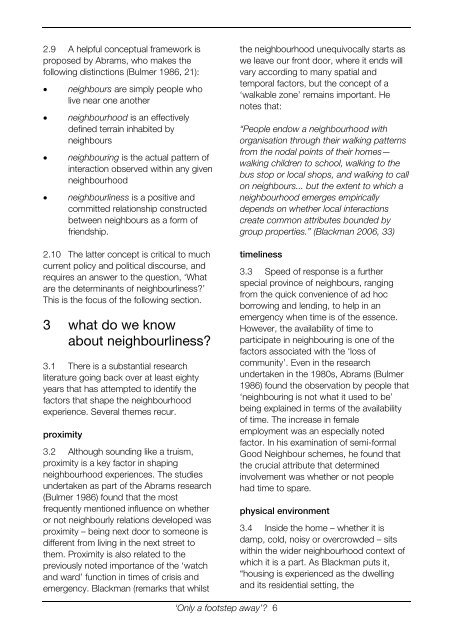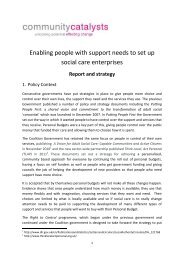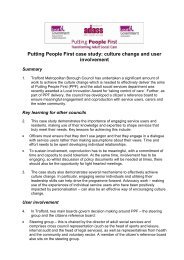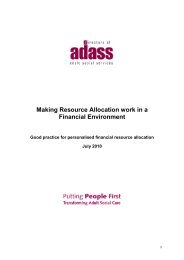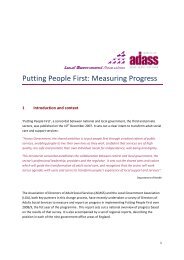'Only a footstep away' - Skills for Care - Think Local Act Personal
'Only a footstep away' - Skills for Care - Think Local Act Personal
'Only a footstep away' - Skills for Care - Think Local Act Personal
- No tags were found...
Create successful ePaper yourself
Turn your PDF publications into a flip-book with our unique Google optimized e-Paper software.
2.9 A helpful conceptual framework isproposed by Abrams, who makes thefollowing distinctions (Bulmer 1986, 21):• neighbours are simply people wholive near one another• neighbourhood is an effectivelydefined terrain inhabited byneighbours• neighbouring is the actual pattern ofinteraction observed within any givenneighbourhood• neighbourliness is a positive andcommitted relationship constructedbetween neighbours as a <strong>for</strong>m offriendship.2.10 The latter concept is critical to muchcurrent policy and political discourse, andrequires an answer to the question, ‘Whatare the determinants of neighbourliness?’This is the focus of the following section.3 what do we knowabout neighbourliness?3.1 There is a substantial researchliterature going back over at least eightyyears that has attempted to identify thefactors that shape the neighbourhoodexperience. Several themes recur.proximity3.2 Although sounding like a truism,proximity is a key factor in shapingneighbourhood experiences. The studiesundertaken as part of the Abrams research(Bulmer 1986) found that the mostfrequently mentioned influence on whetheror not neighbourly relations developed wasproximity – being next door to someone isdifferent from living in the next street tothem. Proximity is also related to thepreviously noted importance of the ‘watchand ward’ function in times of crisis andemergency. Blackman (remarks that whilstthe neighbourhood unequivocally starts aswe leave our front door, where it ends willvary according to many spatial andtemporal factors, but the concept of a‘walkable zone’ remains important. Henotes that:“People endow a neighbourhood withorganisation through their walking patternsfrom the nodal points of their homes—walking children to school, walking to thebus stop or local shops, and walking to callon neighbours... but the extent to which aneighbourhood emerges empiricallydepends on whether local interactionscreate common attributes bounded bygroup properties.” (Blackman 2006, 33)timeliness3.3 Speed of response is a furtherspecial province of neighbours, rangingfrom the quick convenience of ad hocborrowing and lending, to help in anemergency when time is of the essence.However, the availability of time toparticipate in neighbouring is one of thefactors associated with the ‘loss ofcommunity’. Even in the researchundertaken in the 1980s, Abrams (Bulmer1986) found the observation by people that‘neighbouring is not what it used to be’being explained in terms of the availabilityof time. The increase in femaleemployment was an especially notedfactor. In his examination of semi-<strong>for</strong>malGood Neighbour schemes, he found thatthe crucial attribute that determinedinvolvement was whether or not peoplehad time to spare.physical environment3.4 Inside the home – whether it isdamp, cold, noisy or overcrowded – sitswithin the wider neighbourhood context ofwhich it is a part. As Blackman puts it,“housing is experienced as the dwellingand its residential setting, the‘Only a <strong>footstep</strong> away’? 6


